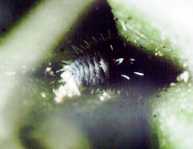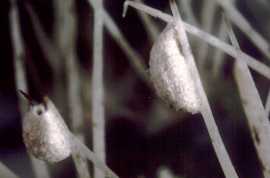
Acanthococcus (= Eriococcus) coccineus (Cockerell) is a North American species which has been spread throughout the world on ornamental cacti. It was recorded for the first time breeding in Britain on ornamental Cactaceae at a nursery in southern England in December 1997. The plants had been imported from the U.S.A. in spring 1997. Control measures taken at the nursery during the winter appear to have been successful in eradicating this pest.
Adult females are oval, rotund, and vary in colour from deep bluish-purple or reddish purple.

Acanthococcus coccineus on Rebutia. © Crown Copyright 1998. Used with permission.
They occasionally have a single mid-dorsal longitudinal yellow or crimson stripe. Short, delicate, translucent wax filaments are present around the margin and sparsely on the head and thorax. They attain a length of 3.0 mm and width of 2.5 mm. The insects lie very close to the plant surface, often in crevices or at the base of spines, and rarely move. At maturity the adult females leave the feeding site and walk to the tips of the spines or off the host plant onto any adjacent surface before producing the ovisac. They become completely encased in a characteristic loose waxy felt-like white ovisac.

Acanthococcus coccineus ovisacs. © Crown Copyright 1998. Used with permission.
Acanthococcus coccineus has been found in Australia, Hawaii, New Zealand, Mexico, southern U.S.A., Canary Islands, Egypt, France, Germany, Israel, Italy, Japan, Brazil. It feeds almost exclusively on Cactaceae and has been recorded on the following genera: Acanthocereus, Astrophytum, Brasilocactus, Cephalocereus, Cereus, Cleistocactus, Echinocactus, Echinocereus, Echinopsis, Harrisia, Hylocereus, Mammillaria, Neobuxbaumia, Neomammillaria, Opuntia, Pelecyphora, Rebutia, Rhipsalis, Selenicereus, Thelocactus and Wilcoxia. The mature adult females have a habit of wandering off the host onto any adjacent surface before producing ovisacs and this can lead to incorrect host plants being recorded. It is parthenogenetic and breeds continuously with overlapping generations, if conditions allow.
Acanthococcus coccineusis considered economically important in the U.S.A. It feeds on the phloem which reduces plant vigour by depletion of plant sap and if left unchecked can kill ornamental cacti. Feeding by a related species, Acanthococcus coriaceus (Maskell), has been shown to consistently reduce root growth in seedlings of the host plants. The 'cocoon-like' ovisacs produced by A. coccineus can lower the aesthetic appearance of ornamental cacti, thereby reducing their quality and commercial value.
If an infestation of cactus felt scale is suspected in the UK the local Plant Health and Seed Inspectorate should be informed.
This information was supplied by
Chris Malumphy
Invertebrate Identification Team, Fera Science Ltd, Sand Hutton, York
Email: c.malumphy@csl.gov.uk
Fera web site: https://www.fera.co.uk